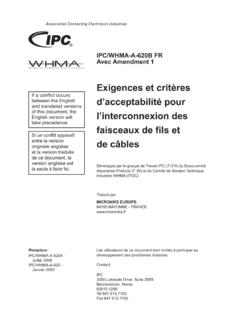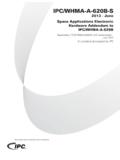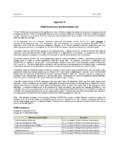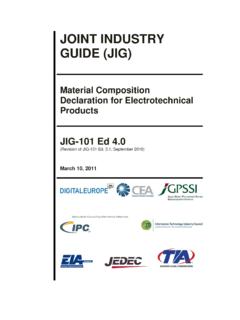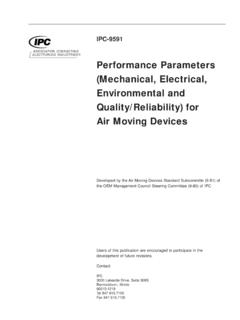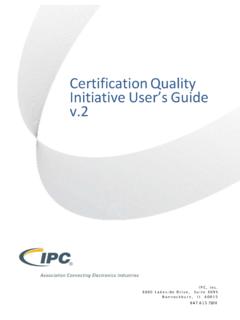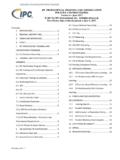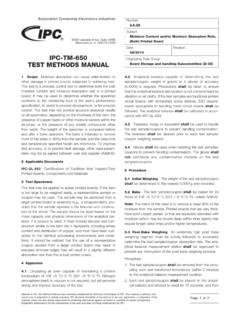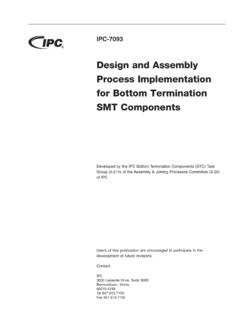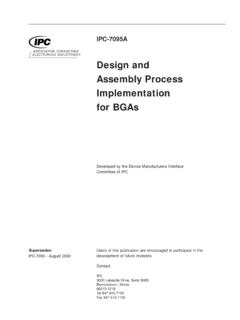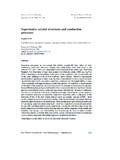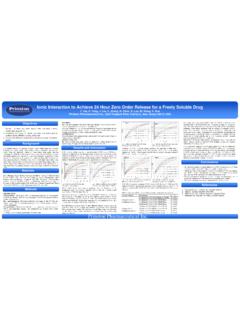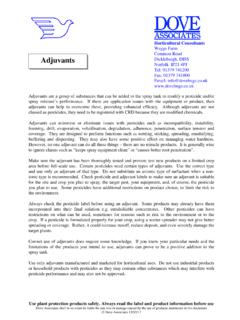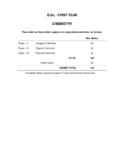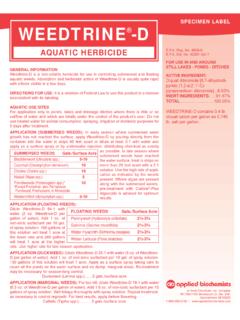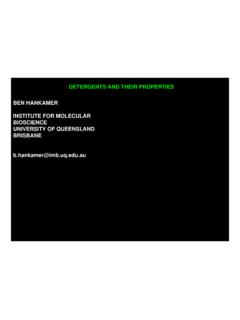Transcription of IPC-TM-650 Ionic Conductivity / Ion …
1 1 PurposeThese tests are used as process controltools; they can be used to inspect printed boards or printedboard assemblies and determine if they conform to the moni-toring level of the user s performance specification. Bulk ioniccleanliness testing may be accomplished by measuring theionizable surface contaminants extracted by the followingthree methods:1. Manual extraction method2. Dynamic extraction method3. Static extraction methodNote:Please note that this method does not predict reliabil-ity and should only be used as a process control RestrictionsMeasurements of Ionic conductivities donot differentiate between different Ionic species.
2 They simplymeasure conductivities (or resistivities) which can be related toamounts of Ionic materials present in solution. There is noidentification of the contribution to the total Conductivity read-ings of any individual Ionic species which may be extractedinto the solution. For measurement of individual Ionic species(type and level of residue) see IPC-TM-650 , Test , Ionic Analysis of Circuit Boards, Ion simplicity, amounts of Ionic materials in solution can beexpressed by a Conductivity factor which is equivalent to themeasured Conductivity contributed by a known amount of astandard, strongly ionized salt such as sodium chloride (NaCl).
3 Ionic residues are therefore usually expressed as equivalentsof sodium chloride in micrograms per unit surface area ( , g NaCl ) of the sample. This does not imply that thecontamination is NaCl but, rather, it exhibits a conductivityfunction which is equivalent to that of the expressed amountof sodium chloride if it were in solution instead of the Ionic tests will not measure any surface Ionic materials whichare not brought into solution because of insolubility, physicalentrapment or inadequate exposure to the extracting , non- Ionic components of the soil will not be ApplicationCaution should be exercised in comparingresults between different test equipment as well as the differ-ent test methods.
4 These methods are applicable as qualitycontrol tools in evaluating the parameters of materials andcleaning process, in terms of how they affect the final cleanli-ness of the board or assembly. As process control tools, theycan be used to inspect printed wiring boards or printed wiringassemblies and determine if they conform to the requirementsof the user s performance specification. It is important tounderstand, no calculation factor can exist to convert datafrom one style of commercial tester to another due to thegreat differences in system responses. See IPC-TR-583. Thismeans it is very difficult to compare data from differentmachines. These procedures can also be used to assistin-process development as general residue indicators, toevaluate flux cleanability, solvent efficiency and generalimprovements of process :Please note that this method does not predict reliabil-ity and should ONLY be used as a process control Applicable DocumentsIPC-TR-583An In-Depth Look at Ionic Cleanliness Testing3 Test SpecimenFollow the equipment manufacturer srecommendations as to sample size.
5 Recommended area cal-culations for the unpopulated printed board and printed boardassembly are the following:Printed Board Surface Area = Length x Width x 2 Printed Board Assembly Surface Area = (Length x Width x 2)+ (1 x up to 50% of the board area)Report the surface area used in the calculation and the per-centage increased in calculating the surface area of a printedboard :There is no universally accepted method for determin-ing the surface area of components. However, the determina-tion of surface area for components should be established ini-tially and used whenever that assembly style is being Manual Extraction DescriptionThis method describes the manual extrac-tion of Ionic material from the surface of a sample.
6 This con-sists of flushing the board surface with a stream of2-propanol/DI water mixture and carefully capturing all of the3000 Lakeside Drive, Suite 309 SBannockburn, IL 60015-1249 IPC-TM-650 TEST METHODS and Measurement of Ionizable SurfaceContaminants by Resistivity of Solvent Extract (ROSE)Date11/12 RevisionDOriginating Task GroupIonic Conductivity / Ion Chromatography Task Group(5-32a)Material in this Test Methods Manual was voluntarily established by Technical Committees of IPC. This material is advisory onlyand its use or adaptation is entirely voluntary. IPC disclaims all liability of any kind as to the use, application, or adaptation of thismaterial.
7 Users are also wholly responsible for protecting themselves against all claims or liabilities for patent referenced is for the convenience of the user and does not imply endorsement by solution before measuring the resistivity of the com-posite Test Equipment and laboratory ware ( , beakers, funnels,storage bottles and graduated cylinders). This plastic warecan be high density polyethylene, polymethylpentene (poly-pentene), polypropylene or equivalent. Glassware cannot beused because it has been shown to contribute Ionic contami-nation in a short time with this 2-propanol/DI water bridge or equivalent Conductivity probeand temperature compensated liquid Conductivity cell appara-tus capable of measuring specific resistivities within a rangecovering at least 100 k -cm to 20 M column.
8 Up to 100% solvent compatiblemixed bed or :Some of these columns are color dyed. This dye willinterfere with test results. Make certain that the column usedhas no Grade 2-Propanol (isopropyl alcohol) purity water (DI water), preferably above 16M -cm water resistivityNote:It is critical to always use wash solution with the samecomposition of 2-propanol/DI water for all comparative solution composed of 75 2% v/v 2-propanol/DI water or 50 2% v/v 2-propanol/DI water. This wash solu-tion must be deionized to a resistance equal to or greater than16 M -cm ( Conductivity less than S/cm). If stored,this wash solution must be freshly deionized prior to use.
9 Typi-cal resistivity of 25 M -cm ( Conductivity of S/cm) canbe achieved. Measurement of the 2-propanol/DI water solu-tion should be performed using a calibrated hydrometer. Thedefault extract solution composition is 75 2% v/v2-propanol/DI Calibration of BridgeThis is essential in the manualmethod because there can be no correlation betweenresistivity/ Conductivity readings and NaCl equivalents withoutcalibration. All future specification requirements are to bestated in maximum micrograms of NaCl equivalent per squarecentimeter ( g NaCl ).Note:Ensure that a proper cell constant value is consideredin any Conductivity calculations. Check the specific conductiv-ity bridge manufacturer s manual for this or purchase (these standard solutions areavailable from equipment vendors, as well as many of thechemical companies) a standard NaCl solution from a weightof ACS reagent grade NaCl salt dissolved in deionized water(16 M -cm resistivity minimum) to produce a final diluted con-centration of g/liter NaCl (5 mL contains 300 g NaCl).
10 Note:It is recommended that dry NaCl be used for this solu-tion. A recommended drying exposure is one hour at 105 Cor one liter of the 2-propanol/DI water solution (atthe calibration temperature of the bridge in use) in a :The 75%/25% v/v or 50%/50% v/v 2-propanol/DIwater solution must be used in this calibration. Water cannotbe used since it is not the test solution used in the test solution used in this calibration should be made a 50 mL burette, add to the liter of test solution,5 mL of the standard g/liter NaCl solution. Stir and mea-sure :If the resistivity is measured, convert to Conductivity bytake the reciprocal, prior to plotting the a 50 mL burette, add to the liter of test solution,20 additional mL of the standard g/liter NaCl solution, fora total of 25 mL.
